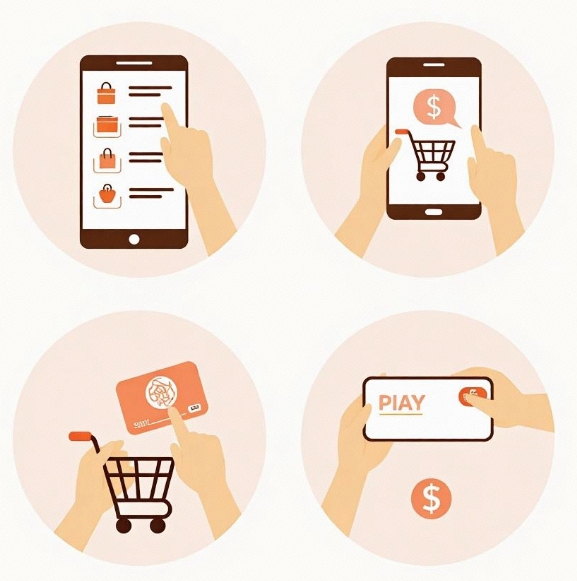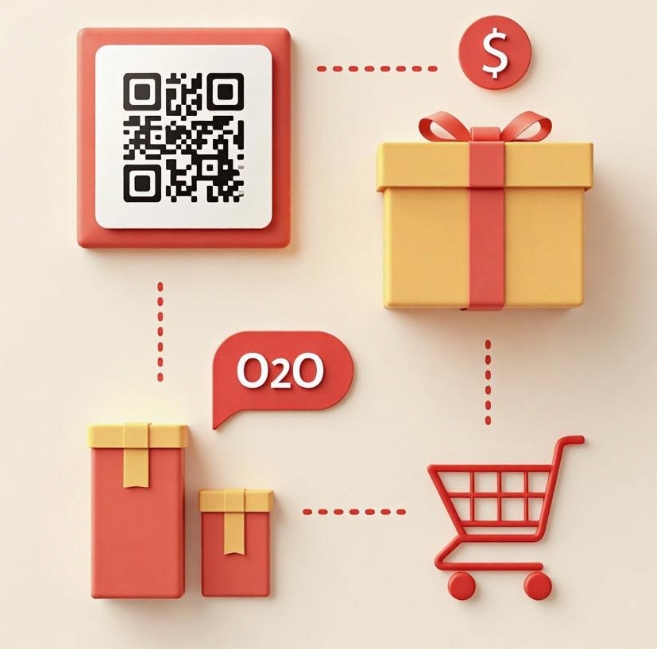Integration of Online Payments and Offline Scenarios in Mini Program Development
- latest articles
- 1.DApp Development & Customization: Merging Diverse Market Needs with User Experience 2.Analysis of the Core Technical System in DApp Project Development 3.How to achieve cross-chain interoperability in Web3 projects? 4.How does the tokenization of points reconstruct the e-commerce ecosystem? 5.How to Set and Track Data Metrics for a Points Mall? 6.What is DApp Development? Core Concepts and Technical Analysis 7.Inventory of commonly used Web3 development tools and usage tips 8.Development of a Distribution System Integrated with Social E-commerce 9.Six Key Steps for Businesses to Build a Points Mall System 10.What is DApp Development? A Comprehensive Guide from Concept to Implementation
- Popular Articles
- 1.Future Trends and Technology Predictions for APP Development in 2025 2.Analysis of the DeFi Ecosystem: How Developers Can Participate in Decentralized Finance Innovation 3.From Zero to One: How PI Mall Revolutionizes the Traditional E-commerce Model 4.DAPP Development | Best Practices for Professional Customization and Rapid Launch 5.Recommended by the Web3 developer community: the most noteworthy forums and resources 6.How to Develop a Successful Douyin Mini Program: Technical Architecture and Best Practices 7.From Cloud Computing to Computing Power Leasing: Building a Flexible and Scalable Computing Resource Platform 8.Shared Bike System APP: The Convenient Choice in the Era of Smart Travel 9.How to Create a Successful Dating App: From Needs Analysis to User Experience Design 10.From Design to Development: The Complete Process of Bringing an APP Idea to Life
With the popularization of the internet and smartphones, an increasing number of enterprises and businesses have entered the field of mini-program development. As one of the most popular applications, WeChat mini-programs have become a key tool for integrating online and offline scenarios for businesses. In this process, online payment, as one of the essential functions of mini-programs, combined with offline scenarios, has promoted innovation and transformation in business models and optimized the consumer experience.
I. Background and Significance of Mini-Program Development
Mini-programs are lightweight applications based on the WeChat platform, characterized by their "use and go" nature, allowing users to access them directly without downloading or installing. Since the launch of WeChat mini-programs in 2017, they have quickly become an important channel for many businesses, developers, and enterprises to expand their online operations. Their simple development process and ability to leverage WeChat's user traffic and social network have gradually made them a vital bridge connecting online and offline worlds.
As online payment has gradually become the mainstream method of consumption, the integration of payment functions in mini-programs has increasingly merged with offline scenarios, not only meeting user needs but also creating more business opportunities for merchants. This integration has not only enhanced the payment experience but also transformed consumer shopping habits and business operational models.
II. The Role of Online Payment in Mini-Programs
Online payment is an indispensable part of mini-programs. By integrating payment interfaces, businesses can facilitate convenient and secure transactions, while consumers enjoy a faster payment experience. Common payment methods in mini-program development include WeChat Pay, Alipay, and bank card payments.
Enhancing Payment Experience
The online payment function within mini-programs significantly improves payment efficiency for consumers. Compared to traditional payment methods, online payment is more convenient, eliminating the need for cumbersome password entry and verification. Consumers can complete payments quickly by performing relevant operations within the mini-program. Whether purchasing goods, booking services, or paying bills, online payment ensures a smoother user experience.Expanding Business Coverage
Online payment in mini-programs is not limited to e-commerce; its application scope is very broad. Whether in the food and beverage, entertainment, tourism, or education industries, businesses can achieve convenient transaction processing by integrating online payment functions. Especially for small and medium-sized enterprises, adopting online payment lowers barriers, helping them quickly expand their market reach and increase revenue.Payment Data Analysis
Online payment also generates substantial data flows, which hold significant commercial value for businesses. Through payment data analysis, merchants can gain deep insights into consumer spending habits, preferences, and payment behaviors, enabling precise targeting of users and optimization of marketing strategies. This data-driven approach allows businesses to better provide personalized services and products, enhancing customer satisfaction.
III. Changes in Offline Scenarios
Complementing online payment is the transformation of offline scenarios. Innovations in offline payment methods have made consumer shopping experiences more diverse and convenient. With the help of mini-programs, offline scenarios have also become more intelligent and information-driven. Through interactions between businesses and consumers via mini-programs, the limitations of traditional offline transactions are broken, offering users richer services and experiences.
Popularization of QR Code Payments
With the widespread adoption of QR code payments, consumers are increasingly inclined to use this method when shopping in physical stores. This payment method is not only fast and convenient but also effectively reduces the risks associated with cash transactions, such as change handling and loss. Mini-program payment interfaces typically support QR code payments, allowing consumers to complete transactions by scanning a code with their phones, saving queuing time and improving transaction efficiency.Digital and Intelligent Store Management
In traditional offline scenarios, businesses often rely on manual cashiering and management, which can be inefficient and prone to errors. However, with the integration of online payment and mini-programs, offline store management is gradually transitioning towards digitalization and intelligence. Businesses can use mini-programs to access real-time sales data, manage inventory, schedule staff, and optimize operational costs. More importantly, they can push promotional information through mini-programs to attract customers and achieve precision marketing.Rise of the O2O Model
The O2O (Online to Offline) model refers to directing online demand to offline services or product consumption through internet platforms. Online payment, as a core component, facilitates seamless transitions for consumers from online to offline. For example, a consumer can reserve a table at a restaurant and pay via a mini-program online, then dine quickly upon arrival without waiting in line. The rise of the O2O model not only creates more sales opportunities for businesses but also enhances convenience and satisfaction for consumers.
IV. Typical Cases of Online Payment and Offline Scenario Integration
With the deep integration of online payment and offline scenarios, many companies have begun exploring this new model and achieved significant results.
Food and Beverage Industry: WeChat Pay and Smart Ordering Systems
The food and beverage industry has been a key area for the widespread application of mini-programs and payment systems. An increasing number of restaurants have adopted smart ordering systems based on mini-programs, allowing consumers to scan a code to access the restaurant's mini-program, view the menu, place orders, and pay bills. Through online payment methods like WeChat Pay, consumers can enjoy cashless payments while dining, reducing wait times and transaction costs.For example, some restaurants have introduced a "scan to order, scan to pay" model. Upon entering, customers simply scan the QR code on the table to access the restaurant's mini-program, order on their phones, and complete the payment. There's no need to wait for a server to settle the bill; after payment, they can leave, greatly enhancing the dining experience.
Retail Industry: Online Ordering and Offline Pickup
Supported by mini-programs and online payment, the retail industry has developed a model of online ordering and offline pickup. Consumers can browse products and place orders on e-commerce platforms or merchant mini-programs, then pick up the items at physical stores. This model not only reduces inventory costs but also increases foot traffic to offline stores.For instance, a major retailer developed its own mini-program, allowing consumers to place orders and make payments within the app. After payment, consumers can choose to pick up their goods at the nearest store. This integration of online and offline significantly boosts sales for merchants and provides consumers with a convenient shopping method.
V. Future Development Trends and Challenges
Although the integration of online payment and offline scenarios brings many conveniences to businesses and consumers, it also faces certain challenges.
Technical Security Issues
Online payment involves significant fund transfers and the transmission of personal information, making security a critical concern that cannot be overlooked. Businesses and developers need to strengthen security measures in mini-programs to prevent vulnerabilities during payment processes and protect user privacy.Integration of Cross-Platform Payments
Currently, online payment still suffers from fragmentation across platforms. Payment tools like WeChat Pay, Alipay, and bank payments have poor interoperability, often requiring consumers to use different tools for payments. In the future, achieving seamless integration and data sharing between different payment platforms will be a key challenge in merging online payment with offline scenarios.Cultivating User Habits
Although online payment is widely used in many areas, some consumers remain hesitant about this method. How to effectively market and educate users to further enhance their awareness and acceptance of online payment will be an important task for businesses.
VI. Conclusion
The emergence of mini-programs has not only provided vast development space for online payment but also offered new ideas for innovation in offline scenarios. With the deep integration of online payment and offline scenarios, businesses can better provide convenient services and experiences for consumers, while shopping and payment methods will become more intelligent and diverse. In the future, with technological advancements and continuous innovation in business models, the integration of online payment and offline scenarios is bound to embrace even broader prospects.
-

How to Increase User Stickiness and Activity Through Mini Program Development
With the development of the internet and mobile internet, mini-programs, as an e···
-

How can mini-program development assist in corporate marketing and e-commerce transformation?
In today's rapidly evolving mobile internet landscape, corporate marketing and e···
-

Offline Functionality Design and Data Synchronization in Mini-Program Development
With the rapid development of mobile internet, mini-programs, as a lightweight a···

 Blockchain
Blockchain












